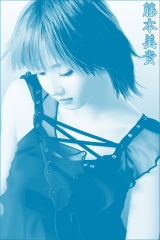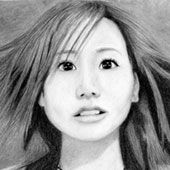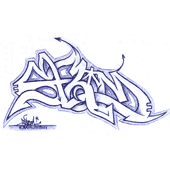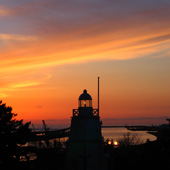Art
The Story
I've been drawing for most of my life. I can still remember a day in kindergarten when one of the other kids showed me how to take a typical 2D drawing of a house (the old "triangle sitting on top of a square"), and extend it so it looked 3D. That sparked the flame.
When I was 9, a friend and I started creating our own comics, "publishing" them under the name KCF (Kids' Comic Federation). My friend was the one with the raw talent. Whenever I thought I had come up with something cool, he had something better, but I learned a lot from him, and even today I still use many of the techniques and principles he showed me.
My encounters with much more talented artists put me off a little — it didn't come quite as naturally to me — but it was a lot of fun, so I kept at it anyway. Around that time, the office where my Mom worked had some of the earliest Macintosh computers, and once upon a time, Macs used to ship with a pair of simple graphics programs called MacPaint and MacDraw. These could be considered the oldest ancestors of Photoshop and Illustrator, respectively. I didn't understand MacDraw at the time, but I immediately loved MacPaint, and took every opportunity to go to my Mom's office and use it.
Digital Art
Using computers for art opened up a whole new world for me. I didn't have a computer at home until 1996 (and didn't have one powerful enough to run most graphics programs until the following year), but when the opportunity arose, I started messing around with Photoshop, Painter, Bryce, Infini-D, and others. Photoshop became my mainstay for both art and design.
In 1998, I started learning how to use Illustrator. I had tried to use it on a number of prior occasions, but it just didn't make sense to me until I finally sat down and learned the basic principles. Even then, it took a lot of practice and involved a lot of frustration, unraveling the whole mystery of it. As I got to know it better, it became my tool of choice for graphic design.
One day in 2002, I was bored. I fired up Illustrator and started tracing the outline of a photo. I thought the result looked cool, and tried a few more. Before I knew it, I was creating increasingly complex illustrations, spending longer on each one, and in the process, Illustrator became second nature to me. My illustrations ballooned into projects spanning days or weeks, culminating in my vectorization of Miki Fujimoto, which took me around 30 hours to complete.
Pencil Drawing
In 2004, after several years of doing digital illustrations, I felt the urge to return to drawing with natural media. I had never tried to draw anything realistic with pencil before, and decided to give it a shot. I had recently found out what a tortillon is (it's a piece of paper, rolled up into the shape of a pencil, which can be used for blending and smoothing), and this ended up being a very important discovery.
The key to realistic drawing is drawing what you actually see, rather than the outlines of the individual shapes. If you're drawing a face, for example, you don't want to draw the outline of the eyes, nose, mouth, and so on; you look for the subtle shadows and highlights that suggest the shapes, and draw those. But drawing soft, blended shadows with a pencil is difficult, and that's where the tortillon comes in.
I was quite surprised by the result of my first attempt at realistic drawing, and have done several more since then. Like my illustrations, my pencil drawings have grown more elaborate and time-consuming. The Ai Otsuka drawing took about 15 hours.
My pencil drawings and illustrations can be found on the Artwork page.
Architecture
In the early 1990s, I became really interested in architecture, particularly the design and layout of houses. I tried my hand at designing several houses, and spent a lot of time wandering around show homes, bothering the architects and sales reps. Yeah, I was a pretty weird kid I guess. I took drafting in high school, and — although I found it pretty boring — I did learn quite a few things that I was later able to apply to illustration and design work.
Graphic Design
In 1996, I got into design, starting with rave flyers and posters. I started designing websites around the same time, but the opportunity for creative design was quite limited by the technology at the time; it was several more years before I was able to build sites that looked the way I wanted them to. Meanwhile, my interest in typography, icons, and symbols in general, eventually led to designing logos.
In 2004, I launched my design company Symmetriq.
Graffiti
I've always had a fascination with letters. My first encounter with typefaces (known in the computer world as "fonts") was with the exchangeable "type balls" available for IBM Selectric typewriters (yet another discovery I made at my Mom's office). I've always enjoyed coming up with new styles of letters, and when I discovered the world of graffiti art, I immediately took to it.
I started doing my first sketches in 1996, as 'Storm' (since 'Stormchild' is a bit long). Most of them were on notepads, scraps of paper, or whatever happened to be lying around, and I don't really have any of those original sketches anymore. I had another wave of inspiration in 1999, and this time I kept a sketchbook. In 2003, I got into graffiti again, and at this point I decided to dive in all the way. I developed a tag, started using markers and spray paint, tried to break out of stylizing individual letters, and move into the more freeform world of 'wild style'.
You can see some of my sketches on the Graffiti page.
Photography
When I was 11, my class went on a field trip to Elbow Falls, just outside of Calgary. To make it interesting, our teacher told us there would be a photo competition, and that we should submit our favorite one after the trip. I wonder if that's what inspired me to start looking at photography as art. I spent the day looking through my camera's viewfinder, and submitted a photo of some evergreen trees shot straight up at an interesting angle. It wasn't really that cool, but it won third prize in the contest, and from that point on, whenever I had a camera in my hand, I was always looking for the next cool shot.
I'm not particularly skilled at, or knowledgeable about photography. I've never owned a professional camera and I certainly couldn't compete with the many truly talented people who are much more into it than I am. But, as with drawing, I really enjoy it, so I do it anyway. I got my first digital camera in 2005, and since then I've finally had the means to dive a lot deeper into photography, and take much better pictures than I was ever able to before.
I've posted some of my favorite shots on the Photos page.
July 14, 2006




